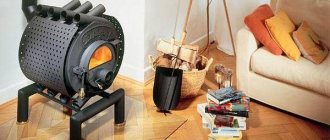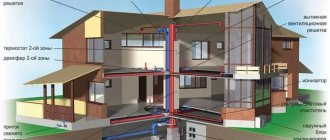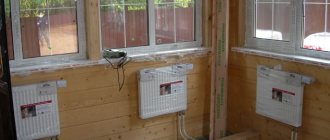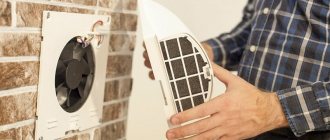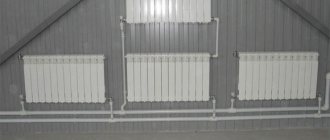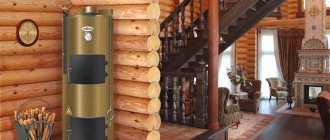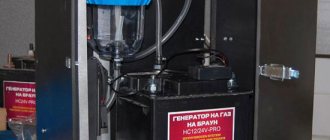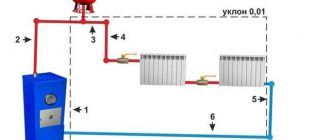Operating principle of solid fuel stoves
Before we begin building a furnace, we need to consider the principle of its operation. To do this, let's remember a little chemistry and physics.
For the combustion process we need oxygen, which is a combustion catalyst. At the same time, the combustion process releases carbon dioxide, which is harmful to humans and must be released into the atmosphere.
Based on this, there are three main zones in the oven.
- Firebox. It is in this zone that the combustion process occurs. The dimensions of the firebox vary depending on the type of fuel burned, the power of the boiler and some other factors. For greater heat transfer, the firebox is lined. Under no circumstances use ordinary building bricks for its laying.
- At the bottom of the firebox there is an ash pan . Its functional responsibilities are to supply oxygen. In addition, solid combustion waste is removed through the ash pit.
- At the top of the firebox there is an exit to the chimney . This zone is responsible not only for the removal of flue gases, but also for the extraction of thermal energy. For this purpose, heating brick stoves for summer cottages are usually equipped with a chimney with several passages.
Brick oven
Solid fuel boiler is the main source of heat. Principle of operation
*
How do we imagine a solid fuel boiler that powers a home heating system? This is a pyrolysis type heating device familiar to many of us. Due to the combustion, first of fuel, and then of combustible wood gas, there is an intense release of heat from the interaction with which the heat exchanger is heated. More precisely, an air exchanger. Heated to a certain temperature in the heat exchanger pipes, the air circulates through a system of channels, heating the interior.
Such a heating device can be installed almost anywhere in a residential building or other premises.
Note: today models of solid fuel air heating units are produced, the design and appearance of which allows them to fit well into the interior of residential premises.
If the home owner wishes, air can be distributed through the duct naturally or under the influence of blowers, which significantly increases the speed and density of the air flow. The boiler usually has a spacious combustion chamber where the fuel burns. The firebox has a special hatch through which firewood is loaded. At the bottom of the combustion chamber there is a grate on which the fuel is placed and the combustion itself takes place. As in other solid fuel units, in the lower part of the structure there is an ash pit - a box for collecting ash and large remnants of unburned wood.
Air heating boiler design
If preference is given to the pyrolysis method of fuel combustion, then a boiler equipped with two combustion chambers is required. In one compartment, as a result of smoldering of the fuel mass, intensive release of wood gas occurs. In the second firebox, highly volatile flammable compounds, reacting with oxygen, ignite, releasing a huge amount of thermal energy. This method is characterized by economical fuel consumption. In the process of burning wood, there are practically no large residual fragments left. An air heating system with a solid fuel pyrolysis boiler is distinguished not only by fast and high-quality heating of rooms, but also by high performance characteristics.
*
Heated air accumulates in the space between the body of the heating unit and the firebox (combustion chamber). This is the heat exchanger in this case.
Due to the air flow, the walls of the combustion chamber are constantly washed with new air flows. Both primary and secondary air are used for heating. Thanks to pyrolysis in the boiler, the main work is done by the primary and secondary air. Primary air masses are the main source of heat. Air coming from outside, i.e. it is preheated to reduce heat losses, and only then enters the firebox. Secondary air is a gas-air mixture consisting of air and hot combustion products.
Note: solid fuel in most cases burns 90%. The remaining 10% is presented in the form of tiny particles that make up the smoke. The main advantage of secondary air is that it is already at a high temperature. No additional heating is required to achieve the required temperature. Due to such air exchange, a high heat capacity of the operating unit is achieved and the efficiency of heating equipment increases.
The selection of secondary air masses is carried out from the very top of the air duct. The intensity of the intake is regulated by the position of the damper. The combustion intensity of this equipment determines the volume of air supplied to the combustion chamber. More air, more intense combustion. Air supply in simple models is carried out manually, due to the natural flow of air. In expensive models, a fan is used for this purpose, which turns on and off automatically. Such fans are called blower fans. To achieve the maximum possible effect of the boiler operation, a smoke exhauster is installed on the chimney, the task of which is to improve the removal of residual combustion products from the combustion chamber.
Today, solid fuel air units of varying degrees of equipment are on sale. Most models include the following systems:
- ignition;
- combustion process control system (temperature sensors, dampers, blowers);
- mechanisms and devices that supply fuel.
Due to the interaction of all systems, the boiler allows you to regulate the heating temperature in the rooms.
Options for increasing furnace efficiency
Increased efficiency due to the air circuit
Throughout history, many tricks have been invented to increase the efficiency of the stove. One of them is the arrangement of an additional air circuit around the furnace. To do this, the furnace walls are covered with an additional layer.
For these purposes, by the way, you can use not refractory, but ordinary double silicate brick M 150. But when lining the stove, you should make a gap between the masonry sufficient for air circulation. Typically this distance is approximately 5 cm.
Furnace air circuit
For air circulation in the air space between the firebox and the outer layer, holes are provided in the upper and lower parts of the outer masonry of the brick fireplace stove. They are necessary for air circulation. They are created by loosely fitting bricks together.
They are performed starting from the second row of masonry. In this case, the instructions instruct to do them in no more than three rows, both at the top and at the bottom. There should be no holes in the upper part, or more precisely in the last two rows of masonry.
The initial process of laying a furnace
It is worth noting that when laying the outer layer, you should be careful not to accidentally cover these holes with mortar.
Due to the natural circulation of air in the gaps of the circuit, heat exchange occurs between the air and the masonry of the first layer. This almost doubles the heating area of the stove, which significantly increases its efficiency.
Increasing the efficiency of the stove due to additional chimney passages
Another fairly common way to increase the efficiency of boilers is to create additional flue passages. But this action must be performed only after careful calculation. Since an increase in the number of strokes leads to a decrease in thrust, and this circumstance can lead to the impossibility of the combustion process.
Brick heating stoves for summer cottages are usually made with no more than three gas duct strokes. This allows you to heat the room as much as possible using natural draft. A larger number of strokes may require installation of forced flue gas removal.
Stove for heating a bath
The key to a good bath is a properly built stove-stove. This is perhaps the most important attribute of a bathhouse. It is this heating in the bathhouse that will allow you to heat the room, heat the water for bathing and create steam in the steam room. To heat a large sauna, you can install a heating stove. If you don’t know how to heat a bathhouse, but decide to build a steam room, a heater stove would be the best option.
Heater stove in the bathhouse
Below we will consider the features of the operation of a heater stove, the principle of operation, as well as the main types.
Principle of operation
In society, fireplaces are associated with aristocratic premises and rich interiors. Therefore, many people believe that heating with a fireplace is too expensive and unusual for their social class. However, a small wood-burning fireplace can warm up a small apartment in a matter of minutes.
Fireplace with air circuit
Modern research has shown that the heating efficiency of conventional stoves can be increased several times by organizing a convection heat transfer scheme. The convection scheme for heating a room uses the physical laws of our world, that is, warm air emanating from the pipes will rise and heat the room.
The main heating equipment in the firebox is the liner in which the air is heated. The liner is surrounded by air pipes. The pipes are connected to the pipe system for air distribution. The air is moved by fans.
It should be noted that air-heated heating equipment can move hot air due to a gravitational system that uses closed ventilation ducts. In such a system, air movement is ensured by the temperature difference between the gases. The gravity system is very demanding on the placement of pipes - the number of turns should be minimal.
Fireplace air ducts
In order for heating fireplaces to efficiently heat the entire room, each room must have a ventilation hole with a grille. To heat the room from all sides, anemostats or closed diffusers are often built into the ceiling.
This heating system is not suitable for heating a ventilated room. That is, the pipes are not routed to the kitchen, bathroom or dressing room. If this recommendation is ignored, an atmosphere with disturbed air pressure will be created in the apartment. In conditions of impaired air pressure, unpleasant odors do not leave the kitchen, but remain in it.
Arguments for choosing an air system
Compared to conventional systems operating on a liquid coolant, air circuits have significant advantages. Let's take a closer look at them.
- High efficiency of air systems. The productivity of air heating circuits reaches about 90%.
- Possibility to turn off/on equipment at any time of the year. Work interruption is possible even in the most severe winter cold. This means that a switched-off heating system will not become unusable at low temperatures, which, for example, is inevitable for water heating. You can put it into operation at any time.
- Low operating cost of air heating. There is no need to purchase and install quite expensive equipment: shut-off valves, adapters, radiators, pipes, etc.
- Possibility of combining heating and air conditioning systems. The result of the combination allows you to maintain a comfortable temperature in the building in any season.
- Low system inertia. This ensures extremely fast heating of the premises.
- Possibility of installing additional equipment that is used to maintain an optimal microclimate. These can be ionizers, humidifiers, sterilizers and the like. Thanks to this, you can choose a combination of devices and filters that exactly matches the needs of the residents of the house.
- Maximum uniform heating of rooms without local heating zones. These problem areas are usually located near radiators and furnaces. Due to this, it is possible to prevent temperature changes and their consequence - unwanted condensation of water vapor.
- Versatility. Air heating can be used to heat rooms of any size, located on any floor.
The system also has some disadvantages. Among the most significant, it is worth noting the energy dependence of the structure. Thus, when there is a power outage, the heating stops functioning, which is especially noticeable in areas with intermittent power supplies. In addition, the system requires frequent maintenance and monitoring.
Air heating is very economical. The initial costs for its arrangement are low, operating costs are also low
Another negative feature of air heating is that the installation of the structure must be carried out during the construction process. The installed system is not subject to modernization and practically does not change its operational characteristics.
If necessary, it is possible to install air heating in a constructed building, but in this case only suspended air ducts are used, which is not aesthetically pleasing and is not always effective.
Advantages of this type of heating
Let's consider the efficiency of savings and stability of the air system:
- Reduce costs by 10-20%. An air-heated fireplace continues to function for some time after extinguishing due to circulating hot air in the pipes. Even after extinguishing, the heating system continues to heat a private home;
- Using hot smoke. The temperature of the smoke escaping into the atmosphere is 170-200 degrees. So why not use this gas as an additional heat source to warm the room? Such fireplaces are equipped with a special air duct for circulating hot smoke;
Air heating operation diagram
Ventilation and heating
The considered advantages of air heating speak eloquently about the effectiveness of such a heating system. Ducted heating systems boast three heating methods:
- Convection. By mixing cold and hot air;
- Heat transfer. The walls of the house are well heated by hot air;
- By radiation. The heat comes from the open fireplace insert.
Such a complex heating system can only be installed during the construction of a new house. It is quite difficult to install such a system with your own hands. Its installation requires an excellent understanding of drawings, significant costs for pipe materials, adapters and sealing agents. In addition, it is better to entrust the installation of the ventilation system to a specialist, whose work, of course, is paid.
Which heating is better - air or water?
The main argument in favor of the air heating option is the absence of radiators under the windows, piping and, in general, an intermediary in the form of a coolant. But even this statement does not stand up to criticism - water-heated floors are also completely hidden, but the intermediary is still present - the air itself.
Clarification. When heating with split systems or heat pumps, freon acts as an intermediary, changing the state of aggregation. Heat is supplied to fan coil units by water or antifreeze; in other cases, energy is carried by air masses.
We suggest comparing water heating with air heating, based on advertising statements:
- The VO system has a higher efficiency. This is not true; the efficiency is the same, provided that in both cases heat generators using the same fuel are used. The exception is air conditioners, which consume 300 W of electricity to supply 1 kW of heat.
- The VO can be turned off in the middle of winter, nothing will freeze, and the pipes will not burst. This is true, but a radiator network filled with antifreeze will also not be affected by frost.
- Low cost of operating the VO. The statement is true for furnaces, air conditioners, fan coil units and water systems. When heating with ventilation, you will have to clean hidden air ducts from dust and bacteria. The operation is performed using specialized equipment.
- For air heating you do not have to buy expensive shut-off valves, pipelines, batteries, combs. True, galvanized ventilation ducts are cheaper than water network equipment. But air ducts Ø300 mm (equivalent to a square 200 x 350 mm) must be laid and sewn up somewhere. The cost of installation will be considerable.
- VO heats rooms faster. Incorrect, VO quickly heats the air, surrounding objects remain cold. Both systems will take the same amount of time to fully warm up.
- Additional equipment for cleaning, humidification, and ionization is used in conjunction with air systems. Air quality improves. That's right, heated floors or a radiator network do not clean the home atmosphere.
The remaining arguments are very unconvincing. Example: using the air method you can heat a room of any size on any floor. It is not clear what is preventing us from laying 2 pipes to the 20th floor, installing batteries or fan coils there. Instead, it is proposed to pull a hefty air duct there.
All the arguments for and against will be presented in detail by the famous expert Viktor Sukhorukov in his video:
Features of the stove device
Fire brick dimensions
It has been proven above that air circulation is much more efficient than traditional fireplace heating. High efficiency indicators are maintained due to the special design of the stove. It is worth noting that gas fireplaces are not much different in the design of stoves.
A cassette fireplace is the most demanding design for the correct arrangement of the stove. To equip it, builders use only refractory bricks or metal structures made of cast iron.
Fans are located above the stove. Practice has shown that heating a house with a fireplace depends on their reliability. Therefore, experts recommend choosing only fire-resistant fans if you plan to install them yourself.
As for decorative elements, their presence is optional for a private home. However, summer residents are actively buying fireboxes with decorative elements with glass doors, modern opening mechanisms, etc. When choosing a stove for a fireplace in a country house, special attention should be paid to the power of the device, which can be determined in the technical data sheet. The power of the stove increases with its size.
Diagram of air heating in the fireplace
Separately, it is necessary to note the closed stove. The lockable design further increases the power of the entire structure due to the smoldering provided by the closed door. As a result, not only the power of the equipment increases, but also the savings in fuel consumption increases due to a decrease in air supply. Thus, a closed firebox is an effective and economical equipment for heating a room.
Self-installation
It should be immediately noted that all the work involved in organizing the construction of a fireplace with an air duct with your own hands is quite labor-intensive. In addition, the process is divided into stages, each of which has its own theoretical justification.
However, this does not mean that it is impossible to independently arrange such a fireplace. If you have ready-made projects and the necessary drawings, you can complete the entire installation efficiently and without significant errors, even with minimal experience in the furnace business.
Many professionals willingly share their experiences. It is recommended to use proven ideas from experienced craftsmen. A ready-made installation diagram for a corner air-heating fireplace will help the novice master at every stage, starting with laying the body itself.
Brick fireplace diagram
Choosing a location for the fireplace
The first preparatory stage is accompanied by the choice of installation location for the future fireplace. Despite the fact that there are many design options, in this case you will have to be guided solely by the practicality of the solution.
For high-quality heating of a house with a fireplace, it is necessary not only to provide the rooms with an air duct system, but also to optimize the length of the ducts. The shorter the length, the better the circulation will be. Therefore, the fireplace must be installed in a corner to utilize the maximum number of rooms.
In large houses it will not be possible to warm up all the rooms, and you will have to put up with this. But in standard layouts you can always find a room that borders on the maximum number of other rooms.
Convenient corner location
Construction of the foundation
In terms of weight, a fireplace with convection heating is practically no different from a classic fireplace. The foundation construction stage will also be similar. A pit is dug so that its depth is 60-70 cm. Depending on the chosen project, fireplaces can have a podium or a rectangular body, like English styles. This will affect the area of the foundation. Its boundaries should be several centimeters larger than the dimensions of the fireplace.
Good to know: How to build a brick fireplace with your own hands, we study the entire technology of the process
To fill the foundation you will need sand and crushed stone. But sometimes the pit is filled with concrete blocks. All this creates a reliable support for the fireplace. As a solution, you should use a masonry composition in a 1:4 ratio of cement and sand. The height of the foundation must correspond to the level of the floor covering. All other construction work must be suspended for the mortar to completely harden.
Wall masonry
Having made a layer of roofing felt on the foundation, you can begin laying the fireplace itself. To take into account the presence of all components and heater channels through which air will pass, the masonry should be carried out in separate rows according to a strictly defined pattern. This principle does not depend on work experience. Even professionals carry out similar actions with the difference that they remember many schemes by heart.
Direct construction of the fireplace
Some fireplace options include a brick firebox. But there are popular models in which a metal firebox in the form of a cassette is built into a brick portal. Measurements show that options with metal fireboxes have slightly higher efficiency than those with brick ones. However, the difference is so insignificant that everyone chooses the appropriate execution based on their own ability to pay.
Air duct installation
In the place where the air ducts pass through the walls of the room, the air temperature is not as high as in the firebox. But it is still necessary to provide for safety conditions. The contact points between the air duct and the finishing materials of the walls are insulated with mineral wool.
The main line itself is made of brick when building a house or from a flexible metal pipe. The master’s task is to thermally insulate this line so that the air retains energy for as long as possible during transportation. You can hide the air duct using a plasterboard box. To do this, a frame is made of a metal profile and sheathed with sheets of heat-resistant plasterboard. In some cases, air ducts are made inside the wall.
A well-installed heating system allows you to effectively heat the entire house using a fireplace, thus combining decorative qualities and technical capabilities.
Mistakes when choosing an air-heated fireplace
The generally accepted scheme for selecting heating equipment is unacceptable in this case. Most believe that the power of the firebox is adjusted to the area of the room at the rate of 1 kW per 10 m2. Time has shown that choosing a firebox for fireplaces for a country house with air heating requires an integrated approach.
Gas stoves that are too powerful lead to overheating of the apartment. Residents have to open windows or reduce the amount of heating fuel they use. Frequent temperature fluctuations provoke colds and other unpleasant symptoms - weakness, dizziness and insomnia.
Fireplace area calculation table
How to calculate the required firebox power for an air-heated fireplace? Experts advise contacting sales consultants with this question. It is necessary to contact a specialist correctly, that is, by providing information on the area of the room, type of ventilation and number of rooms. Only in this case will the seller select the required power of the equipment.
Features of the functioning of the stove-heater
In summer cottages they build family-type bathhouses for themselves, in which one stove-heater is enough. This type of heating in the bathhouse will take on all the main functions. This is precisely why it is important to observe all the details when building a furnace. It is better to make a small stove-stove. This will save space. At the same time, its heating time will be minimal, and it will give off heat for as long as possible. But the most important thing is what kind of fuel it will be heated with. It's best if the fuel is cheap. Popular - water heating baths.
High heat capacity will allow you to get good steam for a long time. In addition, dry heat will be used to heat the room and water for washing. To ensure that everything suits you, when heating a bathhouse with your own hands, take into account the ratio of the size of the stove, the room and the purpose of the bathhouse. Make sure that your stay in the bathhouse is as safe as possible for you and your family.
Advice: Think through to the smallest detail what materials you will use when building a bathhouse and stove so that they are not flammable. Take a responsible approach to the issue of ventilation. Whether it is gas heating in a bathhouse or electric, this will allow you not to get burned from combustion products.
